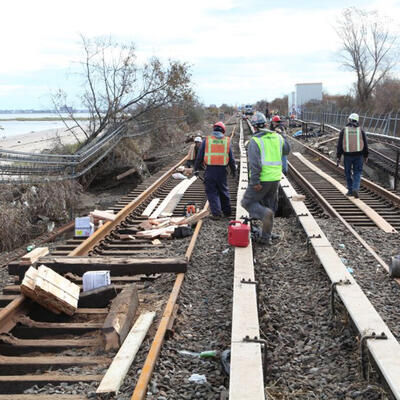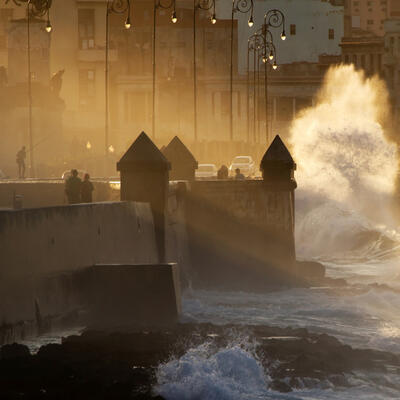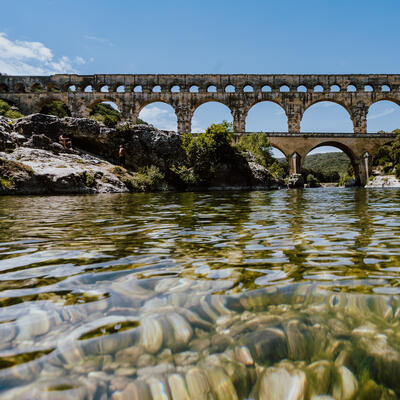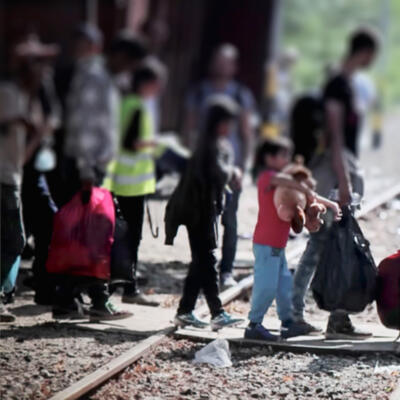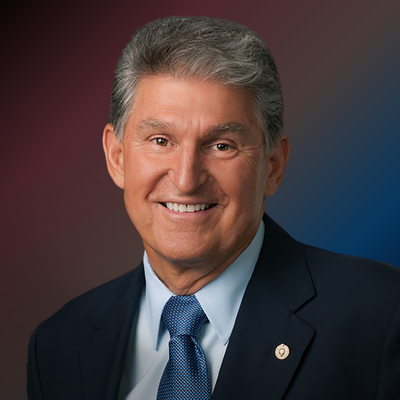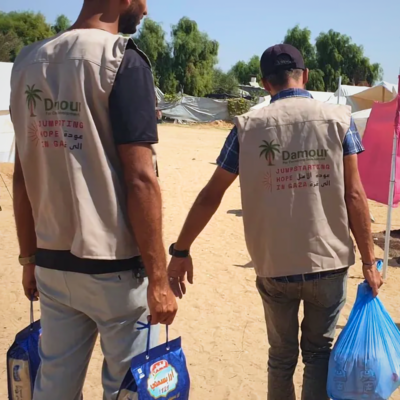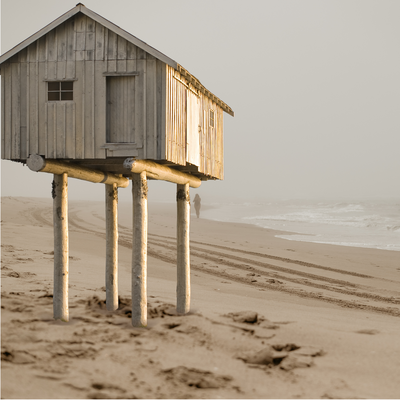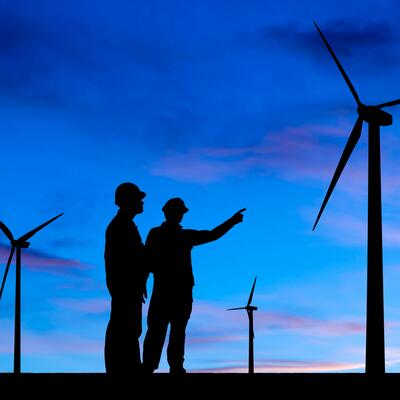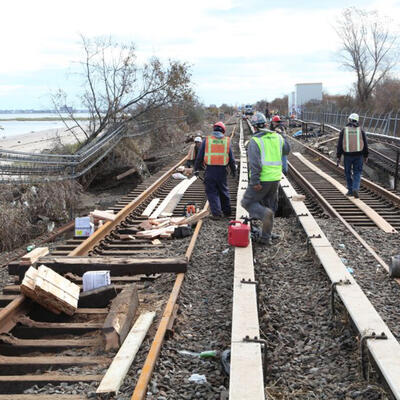
Saket Soni on the People Who Make Disaster Recovery Possible
Guests
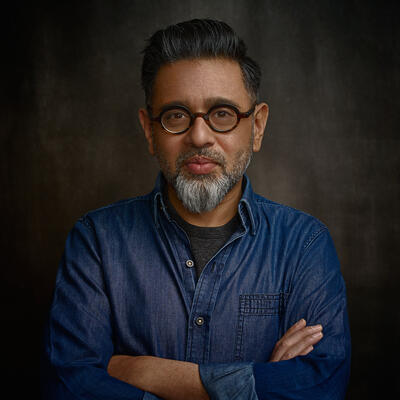
Saket Soni
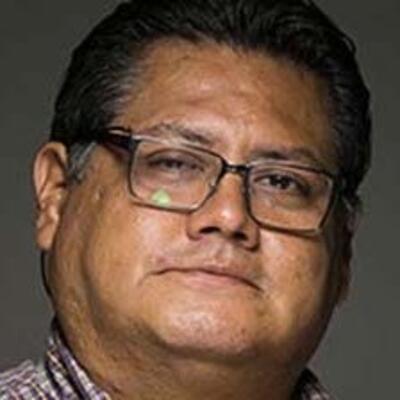
Daniel Castellanos
Summary
As human-driven global warming amplifies the frequency and potency of natural disasters, we are increasingly dependent on one group of workers who live in the shadows: the migrant workforce that arrives to clean up and rebuild.
In his book, “The Great Escape,” Saket Soni tells the personal stories of young men from India who were lured by ads to migrate to America with promises of good salaries and, more importantly, green cards in exchange for working on disaster recovery in the aftermath of Hurricane Katrina. The men had to pay up to $20,000 for this “opportunity” – a not-uncommon part of the deal for such migrants.
“A green card for a migrant worker is the holy grail of immigration, right. But it's not for people who are welders and pipefitters who build refineries who build infrastructure, roads and homes,” Soni says.
What follows is a chronicle of one of the largest human trafficking cases in modern American history. While Soni’s book focuses on the case of these particular men, it showcases the wider inequities and suffering faced by thousands of workers in similar positions.
“They don't want to leave home, but they have to because of economics, because of family security and economic safety,” Soni says.
Yet these are the people doing the hard work of cleaning up as climate-fueled disasters follow one after another.
“I came to understand these workers as the white blood cells of the climate crisis. Each time there was injury these were the workers who arrive to heal.”
Soni is founder and director of Resilience Force, an organization working to ensure a more effective and equitable approach to disaster preparation, response, recovery and rebuilding.
“The challenge the workers face is that this is a deeply subcontracted industry and the rights get lost in the layers,” he explains. “So, there's a worker who’s earning nine dollars an hour on a roof in Florida and if it rains that contractor at the bottom wants that worker to stay on the roof. The worker isn’t documented, doesn't have recourse. If he slips and falls, he'll get injured. So, that's the situation of that worker. But six layers above him, there is a $100 million contract given to an enormous contractor that perhaps has done half a billion dollars of business since Hurricane Sandy.”
Soni sees a future where resilience is an industry like the automotive or steel-making, a source of solid, family-supporting middle class jobs. And as climate disruption brings more severe disasters every year, that resilience corps will become an essential part of our new world.
Episode Highlights
16:05 Daniel Castellanos on the conditions he faced as a migrant worker hired to clean up after Hurricane Katrina: “They put us eight people in a room, in a little tiny hotel room... Eight people in bunk beds.….We joked, “oh, it's a five star hotel. Well, five star because there is a hole in the ceiling that you can see five stars.”
36:30 Saket Soni on how experienced and skilled this mobile workforce has become after responding to tens of disasters in succession: “You've got these people who have done it again and again, people who can make miracles happen. I've seen workers rebuild areas the size of football fields in a matter of days because they can. But they're vulnerable while they do it. They're not paid enough, if at all. If they report abuse, they face retaliation, threats of deportation. And the other problem is there aren't enough of them. That's why our vision is a protected workforce, but also a much more expanded workforce so that America can become climate resilient.”
50:22 Saket Soni on key changes Congress should make to improve disaster resilience: “I think the top three would be adding worker protections to every dollar that goes to the ground to rebuild and repair so that workers are safe. Secondly, adding a racial equity lens so that those dollars specifically go to Native Americans, to Black and brown homeowners, to people who are renters and not just homeowners, to the elderly, to the uninsured….And the last thing just is that right now FEMA isn't allowed to make permanent repairs to homes.”
Resources From This Episode (2)
Full Transcript
Note: Transcripts are generated using a combination of automated software and human transcribers, and may contain errors. Please check the actual audio before quoting it.
Greg Dalton: This is Climate One. I’m Greg Dalton. Unjust labor has been an ugly part of the American economy since the nation's earliest days.
Saket Soni: Here we are again facing the oldest of problems: captive workers coming to rebuild infrastructure after a climate disaster.
Greg Dalton: Much of that labor is done by immigrants from other countries swindled into work agreements filled with false promises, including getting legal status.
Saket Soni: A green card for a migrant worker is the Holy Grail of immigration, right. But it's not for people who are welders and pipefitters who build refineries who build infrastructure.
Greg Dalton: Yet these are the people doing the hard work of cleaning up - as climate-fueled disasters follow one after another.
Saket Soni: I came to understand these workers as the white blood cells of the climate crisis. Each time there was injury these were the workers who arrive to heal.
Greg Dalton: Saket Soni on the People Who Make Disaster Recovery Possible. Up next on Climate One.
Greg Dalton: This is Climate One, I’m Greg Dalton. As human-driven global warming amplifies the frequency and potency of natural disasters, we are increasingly dependent on one group of workers who live in the shadows – the migrant workforce that arrives to clean up and rebuild.
In his book, “The Great Escape,” Saket Soni tells the personal stories of young men from India who were lured by ads to migrate to America with promises of good salaries. And, more importantly, green cards in exchange for working on disaster recovery in the aftermath of Hurricane Katrina. The men had to pay up to $20,000 for this “opportunity” – a common part of the deal for such migrants. What follows is a chronicle of one of the largest human trafficking cases in modern American history. While Soni’s book focuses on the case of these particular men, it showcases the wider inequities and suffering faced by thousands of workers in similar positions. Soni is founder and director of Resilience Force, an organization working to ensure a more effective and equitable approach to disaster preparation, response, recovery and rebuilding.
Soni profiles many of these young Indian men who were swindled into captive labor, including Aby Raju, who was skeptical of the American pitch. I asked Soni to explain the personal family and social pressures that compelled Aby to go against his better judgment and come up with $20,000 that he didn't have for this job.
Saket Soni: Aby is like a lot of young people in India. He went to school up until about 10th grade. And then after that to support his family he got a job fixing roofs for about a dollar a day. He went to Mumbai to the big city for a better job, but that wasn't quite enough. Indian prices were rising just like here, there was the pressure of inflation. His parents were getting old. So, he went out to Bahrain for an oil job. He built an oil refinery. And for a while that money was enough but then that wasn't enough. Came back to India and he now as a young adult, saw his family on the precipice of economic collapse; he didn’t know what to do. So, when he saw that ad for green cards in America, he thought it was a way out. He was initially skeptical, but when he was told it would cost $20,000, when he found the offer credible, he decided somehow to make it work. Because the way he put it to me, you leave the ones you love to help them live.
Greg Dalton: That's pretty powerful. And he is just a typical person. There's many Abys out there, right? Many people making the choices that he made and going down the path that he did.
Saket Soni: Yeah. There are many, many millions of people like him. They think of the only viable career that they will ever have is as a migrant worker. They aspire to be migrant workers. They don't want to leave home, but they have to because of economics, because of family security and economic safety. And the thing that was atypical in Aby's case was a person like him would usually never make it to America. Indian immigration to America, professional immigration has largely been tailored for highly educated people to come into the industries of medicine and tech. Aby is not one of those people. A green card for a migrant worker is the Holy Grail of immigration, right. But it's not for people who are welders and pipefitters who build refineries who build infrastructure, roads and homes. So, that's when an American attorney shows up in India and convinces Aby that it's real. Aby thinks it's a chance of a lifetime.
Greg Dalton: And when he and hundreds of other immigrant workers like him arrived on the Gulf Coast, they could scarcely believe they’re in America. It didn't match their imaginations at all. They were brought to fenced in labor camps. Describe the conditions in these man camps.
Saket Soni: The conditions were awful. Aby and about 500 other workers thought they were coming on green cards for good jobs. But the first thing they learned were there were never any green cards. They came in on temporary visas that let them live and work legally in the United States just for a few months. During that time, they were bound to one employer; they couldn't leave, they couldn't work for anyone else, if the employer was abusive. And they worked round the clock shifts and lived in a labor camp on company property, surrounded by barbed wire fences. For breakfast each morning they were eating frozen rice which they warmed up for themselves, not in a microwave, but by sucking on the rice. That was their only meal to give them the sustenance to do really hard physical labor. So, the conditions were absolutely awful. But the real indignities, the deepest indignities that they faced, I learned about once I started getting to know the workers. So, for example, Aby, one day was 20-feet high on a platform doing really, really dangerous complicated welding work when he got a phone call. He picked up. It was his pregnant wife calling from 10,000 miles away in India. She was about to go in for surgery. And then the phone died. And so, there was Aby wondering when he would next see his son, and in fact he didn't see his son that was born that day. He wouldn't meet his son for another three years. Those were the kinds of indignities that propelled the men to escape from the camp and launch them into their freedom march.
Greg Dalton: These men literally were trapped inside these fences and they couldn't switch employers. At one point, a worker named Jacob says to you, “In Dubai, in Bahrain, in Baku we know how to get free. But how to get free in America?” How did you answer him?
Saket Soni: Yeah, I remember that night very vividly. It was the first time I met Jacob and in his particular English what he was asking was really technical. What he was saying is, “Look, I've been a captive worker in the Middle East. I've been a captive worker in Bahrain or in Baku.” And when you're a captive worker in the Middle East if it gets really bad if conditions are really abusive, there is recourse, there's a way to switch from one employer to another. But what about Mississippi? What about the United States? How do I switch from this abusive employer to another? That's what he was asking. But in his particular English the way the question landed on me it seems like he was asking something far more profound. He was asking a question as old as America. Captive labor has been a problem in American economies since the beginning of America from --
Greg Dalton: 1619.
Saket Soni: Right. Absolutely. From American slavery to American indentured servitude all the way to the American Bracero Program that brought in immigrants. And what he was saying was, look, now at the dawn of the climate era in the most contemporary of times here we are again facing the oldest of problems. Captive workers coming to rebuild infrastructure after a climate disaster.
Greg Dalton: Yeah, the land of the true free thing is -- people are more free in labor markets in Dubai and Bahrain, that's really striking. Aby is just one of many individuals whom you personalize and humanize in the book “The Great Escape.” Who else stands out to you?
Saket Soni: Well, one worker who really stood out a lot was someone I met in the labor camp who became a partner and eventually a brother to me. The person who helped me devise the entire great escape. His name was Rajan. He was from two towns away from Aby. He was the kind of partner a labor leader dreams of. He was someone from inside the labor camp who would meet with me clandestinely and he taught me about welding and pipe fitting. He taught me about the work inside the labor camp, what the company was doing. He also taught me how to cook. And I'd smuggle him Indian spices from outside. He'd take over the cafeteria in the labor camp and cook these meals. And the meals, all that Indian food, was his organizing tool to help the workers, to convince the workers to give me an audience to hear from me about an option outside the labor camp. He was the one who helped me convince 500 workers that they should escape. And when it came time to get them out heist style it was a remarkable event over successive nights with the help of wild turkey whiskey, terrible gas station flavored cigars and a fictional wedding that Rajan and I were putting on at a hotel ballroom. Rajan helped me ferry workers, five, six, at a time over the Pascagoula River to a hotel and that's how we engineered the great escape.
Greg Dalton: Wow, really does sound like a great escape. You’ve said that the hardest thing that you are up against with these workers wasn't their fear, it was actually their faith in America. What do you mean by that?
Saket Soni: Well, when the workers overcame their fear and escaped from the labor camp, they now faced new fear. We were hiding 500 men in a hurricane-ravaged hotel that was in disrepair since Katrina. The only place we could afford to put up 500 people. And the workers were sitting there waiting for the Department of Justice to act on their human trafficking complaint. They filed a complaint against the company, alleging human trafficking and forced labor. And usually in these kinds of cases the DOJ sends an investigator. In this case a week went by and no investigator arrived. So, what the men decided to do was march to DC to the doorstep of the Department of Justice. We set out on a freedom march from New Orleans to Washington. Men carried signs that said, “I am a man” and “Dignity” through Alabama, Georgia, through the vast stretches of the American South. And although they were jeered at and bottles were pelted at them from passing cars, those kinds of blows only increased their faith because in their mind they were walking to Washington. They were walking to the seat of government and they were going to get justice. In fact, they called it the department for justice; it was right there in the name. As soon as they arrived in Washington, they were gonna get justice. So, they had this incredible faith in the American system, a lot more than most Americans, I think. We didn't know that there was a, deep in the federal government, there was a pretty extraordinary advocacy that we would find. But along the way the men had this incredible faith.
Greg Dalton: And how long did it take for them to get justice?
Saket Soni: Well, the great escape took three nights. The hotel hideout was eight days. The march took 14 or 15 days. But the story was three years long. It took three years for Aby Raju to be reunited with his wife and his son. That finally happened at the Atlanta airport when his son was already three. Aby finally reunited with his wife Bincy and their son and started their American lives.
Gre Dalton: We’ll get back to our interview with Saket Soni later in the show, but we wanted to hear firsthand from one of these migrant workers. Daniel Castellanos is director of workforce engagement with Resilience Force. He told Ariana Brocious about his personal experience working in disaster recovery:
Daniel Castellanos: I was brought from Peru, my original country, to New Orleans, Louisiana after the aftermath of Hurricane Katrina, me and 300 more workers came to rebuild the city after the hurricane. And we were exploited. They offer very good wages. They said you’re gonna be paid $15 the hour. In regular time, in overtime, a 60-hour guarantee. It was a very good amount of money, but in order to do that, you have to invest $5,000 to get the visa. Basically we came to New Orleans with a big debt. When we arrived, they made us sign papers in English, even though the 300 workers don't speak English. Spanish is my first language, you know, and they made us sign with no read. They said you have to, you want to work? Just sign.
Ariana Brocious: So you're $5,000 in debt just to get there, and then you have to sign away rights that you're not even sure of because you can't understand the language of the paperwork. And then what's the work itself like?
Daniel Castellanos: I am an engineer in Peru, you know, and I speak a little English, you know, and this is the reason that they said you are gonna be the crew leader, and all the people that we hire in Peru, there were people that, that they were working in construction, but when we arrive, even though all the promises that they gave us, they said the money, the 60-hour guarantee of work, a good place to live, they were false, because when we arrived, they said, okay, we don't have the work doing the rebuild. You’re gonna work in a hotel. And we are not paying you the $15 or $16 they promised us. They pay $6.02 per hour. And they don't give us the 60 hours. They give us 20 hours.
Ariana Brocious: So you're getting way less money per hour. You're getting less hours per week. And the work itself is not at all what it was described. What were the conditions like in terms of where you were living and the job site that you were working on?
Daniel Castellanos: The conditions were very, very bad. They put us eight people in a room, in a real tiny hotel room, not in a big suite. Eight people in bunk beds, and they have holes in the ceiling. And I ask the supervisor if we are gonna work here or we are gonna live here. And he said, he said both. We joke, they said, ‘oh, it's a five star hotel.’ Yeah, five star, because this is a hole in the ceiling and you see five stars. This is the joke that we are doing.
And, and actually the conditions were terrible. When you are coming to the United States, you think about the freedom land, you know, the land that you could restart yourself and have a lot of opportunities.But you know, when you come with a visa like this, because I came legal to the United States, brought by a company to rebuild a city, you know, you think it is gonna be better, but it was worse than coming undocumented. When you cross the border, you are free to go to another job. I wasn't, you know, because the name of my owner was in my passport. If I tried to go to another company, they immediately call immigration and I will be deported.
Ariana Brocious: So even though it was legal immigration and you were given a temporary visa, you were definitely exploited as the term you used because you weren't able to transfer employers. You were stuck in that situation.
Daniel Castellanos: The situation was getting worse and worse and worse, because for me, for example, only was the $500, but for the Dominicans, they forced them to sign a paper in Dominican Republic saying that if you don't come back, you lose your home, you lose your house. You know, the first month after a disaster, they said, come in, come in, help, help, help. They don't care about your status. They don't care about who you are, if you are speak English or not. They want help, you know, to clean up the debris, the trees, the blue tarps and all of this. But then a few months after that, they start thinking, oh look, look, these guys are illegal, or they are Mexican, or they don't speak the language, and the police at the same time start chasing you, bothering you, putting tickets for anything, you know, only for racial profile, basically. Because you are driving and you have a Texas plate or Louisiana plate, you know, and they stop you because that, and they say, okay, you don't have a paper. A few days ago, I was going with one with our members to the court because he got a traffic ticket because he doesn't have a driver license from the United States, and he has a driver license for his country. I was waiting in the court and I saw 60 people in the same situation, and all the people were charged $520. So it's a cash cow for the county. They don't arrest them. They put a ticket, continue working, but again, they gonna catch them and put a ticket. This is a process of getting money from them. Part of the things I'm doing now is try to connect the workers with the governmental offices in the local place to raise their standards of them, because right now they're sleeping in the parking lots. They don't have a shower. They were chased by the police.
Ariana Brocious: The work you're doing now, as you said, is to improve workplace conditions for these migrant disaster workers and looking into the enforcement of workplace standards. We know that the climate is accelerating the rate and occurrence of these natural disasters. So, in your mind, what does the future look like for people who are working on these disaster recovery projects?
Daniel Castellanos: There is a lot of room for, for people that are gonna work there because as you said, unfortunately the global warming is real. There is a lot of people that, they're gonna suffer with not only hurricane, you see the wildfire, you see snow, snow storm, you see tornadoes. So that means that the people are coming into this new way to work, but the companies take advantage of the immigration status. And after they deliver the job or they finish the job, they're not paying. And actually that's one of the biggest problems that we are having in any place that we go. You know, and this is a challenge for us, but we try to move forward because they're workers too, you know, and there is a lot of challenge in my job. But, you know, I like challenge and I try to improve the situation for all.
Ariana Brocious: Well, Daniel, thank you so much for sharing your story with us. This sounds like incredibly important work. Daniel Castellanos is Director of Workforce Engagement at Resilience Force. Thank you again for joining us on Climate One.
Daniel Castellanos: Thank you, Ariana.
Greg Dalton: This is Climate One. I’m Greg Dalton, and we’re talking with author Saket Soni about the people who make disaster recovery possible. Given that so much of the disaster recovery work is triggered by burning fossil fuels, I asked him to share his own climate awakening journey.
Saket Soni: I was a labor organizer and my journey started with helping protect workers in what had become the world's largest construction site. The post-Katrina flooding had turned the American Gulf Coast into the largest construction site on earth. And the workers were black and brown rebuilders standing under a 60-foot tall statue of Robert E. Lee. And each morning they’d be picked up by contractors and I get on the buses with them and go out to the distant dark corners of the Gulf Coast protecting them as they rebuilt. Katrina was supposed to have been a once in 100-year event. That's what it was called a hundred-year flood. The truth is, since then there have been over 200 billion-dollar disasters. And as these disasters grew more frequent and more destructive workers would call me from new places from Houston from North Carolina from South Carolina then from the Midwest. And I'd go to these places to protect them. And what occurred to me was that it was the same workers, many of the same people who stood under the Robert E. Lee statue were now fixing newer and newer places after newer and newer disasters. And I came to understand these workers as the white blood cells of the climate crisis. Each time there was injury these were the workers who arrived to heal.
Greg Dalton: You know I've lived through numerous California wildfires that are climate amplified disasters the displaced people. And I've welcomed first responders to stay in my home. I've seen firefighting helicopters fly directly over my home. And yet the people who come afterward were invisible to me until I read your book. I'm somewhat embarrassed to say I'd never thought about the, knew they existed. So, how are the fates of resilience workers intertwined with the circumstances of people who are displaced by climate disasters because those are the people that I see in the media and I thought about, not the workers.
Saket Soni: Absolutely. Look, you know, we spend a lot of time and attention on a disaster for the 48 hours that follow, right. People are coming out of emergency shelters and they’re coming back into their homes. That's when the cameras usually leave. What I see, what my team at Resilience Force sees, is what happens after the cameras leave. And this is what happens. After a flood or a hurricane or a fire a clock starts ticking. The first race is to get people back in their homes. To do that you need to rebuild sometimes tens of thousands of homes so that people can turn the lights back on. The next race is to rebuild the community infrastructure, schools, the hospitals, so that a tax base can stay. Because how do you stay in your home if your child's new school is three hours away, right? And the last race is then the long race to build a viable economy to bring in investment to rebuild economic development to turn this place into an economy that can thrive, right? All of that depends on resilience workers. And in fact, after a hurricane or a flood or fire people are under enormous pressure. Everybody's waiting for the workers. And the workers are waking up in their cars at a Home Depot. That's when the real rebuilding, the real recovery begins.
Greg Dalton: We've been through some dramatic biblical floods in California in recent weeks. What's happening now that those floods killed 22 people, we've seen certain headlines. What's happening outside of the headlines outside of the spotlight in the wake of the California floods?
Saket Soni: Well, you know, we’re still waiting to see what the true impacts of these rains and these floods will be. But what we know now, what we can predict is that huge numbers of homes, streets, schools and hospitals will need to be repaired. Floodwater when it enters a home or school you know what you have to then clean-up is not just the water but everything that was in the water. So, this is a long slog. A lot of workers for a long time will be cleaning up so that people can be safe and healthy again in their homes and schools and in their cities. The other thing that's happening is a lot of working-class people and poor people particularly for example, farmworkers. Farmworkers are working in fields that are flooded. That means they are now out of work. We think of wine country as being inhabited by the wealthy but wine country is also inhabited by the hotel workers the teachers and farmworkers who live there and who serve the area. And all of those people are undergoing enormous economic disruption. That's gonna take a long time to come back. I mean just think about the average American family and how much money they have in their pocket. If you come home to a fridge that doesn't connect to electricity anymore and you lose all the groceries in it that’s $600. Very few people have $600 lying around. So, this is gonna have a huge economic toll that will play out in people's lives for a long time to come.
Greg Dalton: Right. And lot of secondary effects floods, you know, creates mold that's complicated and expensive to deal with. It used to be that most disaster recovery was done by local mom-and-pop operations. Now 17 years after Katrina there are over, you mentioned 20, billion-disasters every year and disaster recovery is big business. What's the scale of this emerging industry?
Saket Soni: Well, you know, when I used to stand in the shadow of that Robert E. Lee statue most of the contractors that would come to pick up workers were small mom-and-pop shops. There was a van or two and some kind of you know ad hoc payroll system. A lot of these construction companies were new. What's happened since then is that an entire economy has grown. There's this $2 trillion resilience economy as FEMA money, HUD money, other public spending, and billions of dollars of insurance money have come in to help prepare to pay for repairs. You’ve had the growth of an economy. So, on one hand, that means the growth of a workforce. The ranks of resilience workers, the legion of workers that arrives to rebuild and repair has grown. So have the companies. These companies have consolidated they’ve merged. Banks will only lend to a certain size company. So, companies have to get bigger. And so, these companies have turned into giants. There is a very mature disaster restoration industry full of enormous companies, many of whom are now owned by private equity investors, private equity companies see the future. They see that profit can be derived from climate disasters. And so, they're buying up these companies. And so, for example, the state of California is a large institutional investor in the disaster restoration industry. There are huge amounts of dollars for --
Greg Dalton: Are there labor protections, I would think with state funding, government funding, that there would be some labor protection so it's not exploited workers from India doing the work.
Saket Soni: Well, we’re fighting for labor protections and some states are better than others. But the challenge the workers face is that this is a deeply subcontracted industry and the rights get lost in the layers. So, there's, you know, that worker who's earning nine dollars an hour on a roof in Florida and if it rains that contractor at the bottom wants that worker to stay on the roof. The worker isn’t documented, doesn't have recourse. If he slips and falls, he'll get injured. So, that's the situation of that worker. But six layers above him there is a $100 million contract given to an enormous contractor that perhaps has done half a billion dollars of business since Hurricane Sandy. So that's the contracting system. And we need to clean this up. Many more workers will work in dangerous, difficult conditions if we don't, that's really some of the work that resilience force is doing.
Greg Dalton: We often hear about a just transition from fossil fuels that includes people marginalized by unbridled capitalism driven by oil, gas and coal. Preparing for our conversation, I learned of a new term: just recovery. Jayeesha Dutta at the University of New Orleans writes that the status quo in this area is “aid, extract and displace” which is we’ve heard some of that from Katrina and elsewhere. And asserts that a just recovery would include respond, recover and rebuild. Can you unpack that vision for a just recovery?
Saket Soni: Absolutely. Jayeesha’s work is prescient and always on point. I completely agree with her. You know what we're focused on is a just recovery with an equity frame and a racial justice frame in which workers are protected and building their own personal economy through a family supporting job building their wealth through this work. And a recovery where residents coming back are gaining from all the dollars circulating in the system. What you have right now for poor people in this country recovery is robbery. It's not just disasters that create inequality. It's importantly, American recoveries. American disaster recovery is based on a midsize Pennsylvania flood that happened in the 90s, which hit mostly insured homeowners. Today disasters are much bigger and they hit the uninsured. They hit renters. They hit people without personal wealth. All of these people spend down their own money trying to recover and the government help doesn't come fair enough or fast enough. That's the equitable recovery we need, the just recovery we need is one that builds worker rights and worker protections and turns resilience into a significant source of jobs for middle-class growth and that helps residents in disaster hit areas keep their health and wealth and build.
Greg Dalton: And I've talked to other guests about how people controlling public dollars want to have the biggest impact for those public dollars to be accountable to taxpayers and that provides a bias toward wealthier neighborhoods with higher property values. So, the people who need it least are gonna, you know, better suited to get the government money because that’s where the property value is. This cycle seems to be repeating itself.
Saket Soni: Yeah, absolutely. And that's why Congress really needs to rewrite the rules of recovery in the United States. The rules are wrong. The way they're written money will always float towards the already wealthy and seep away from those who are not.
Greg Dalton: Right. Money flows toward power. According to a New Yorker article that features your work “chasing disasters requires a labor force that is open to arduous work and is instantly mobile.” So, the big companies rely on ill-regulated group of subcontractors and brokers as you're talking about. The New Yorker goes on to say that after a disaster, a contractor may owe $30,000 to each worker by the time the last paycheck is due and instead of paying, they'll often call ICE or the police. Is that still happening and what's in place to protect those workers?
Saket Soni: Well, payday raids are now widely expected. People hold their breath on payday and don't know if at the end of the day they'll see a paycheck or the inside of a jail. The bigger problem is that we've come to rely on a group of workers that’s so vulnerable with so little protection. And our sense of emergency after disasters lets this become the norm. When I go to sites that are hit by hurricanes or floods and fires. I usually ask for a show of hands. I show up at the Home Depot when people are waking up. I show up at whatever flooded school or home the workers are sleeping in. And we gather people and we ask people how many hurricanes have you worked, how many fires how many floods. Most of the time people have worked at this point, 10, 15 or 20 disasters. So, you've got this extraordinarily skilled workforce. You've got these people who have done it again and again. People who can make miracles happen. I've seen workers rebuild areas the size of football fields in a matter of days. You know, because they can. But they’re vulnerable while they do it. They're not paid enough, if at all. If they report abuse, they face retaliation, threats of deportation. And the other problem is there aren't enough of them. That's why our vision is a protected workforce but also a much more expanded workforce so that America can become climate resilient.
Greg Dalton: And your organization Resilience Force has initiated a number of legal actions against companies that hire recovery workers and then expose them to unsafe working conditions. How do the big companies shield themselves from liability by some of the layering and contracting I guess you mentioned? So, what are the companies doing in response?
Saket Soni: Well, a lot of the companies subcontract in order to avoid responsibility. They don't want to be responsible for workers and their conditions. But I'll tell you a different kind of story. We were in Louisiana after a recent hurricane and met with a group of workers who hadn't been paid from a job they were doing. They were rebuilding about a dozen public schools for a Louisiana school district. And we got into a terrible fight with the contractor. Workers were practically on strike. They were fighting for their paychecks. And we took the fight all the way up to the top contractor. We basically, you know, woke the CEO up on Thanksgiving Day with a letter. And what started as a really tense negotiation between him and me turned into a long-term partnership. This ended up being a very enlightened CEO, a man by the name of Mark Davis, a really great leader in this space who decided to take the workers at their word believe them, poll up the contractor fix the labor dispute pay the workers back out of his own pocket and then we built a partnership to clean up the industry. So, that's an example of a corporate leader who's doing the right thing because he had an enlightened self-interest. He sees that he needs this workforce. He sees that he needs them to be skilled and trained and we can provide that for him. And I think more and more companies will see the light and start doing what he's doing.
Greg Dalton: Yeah, that sounds like enlightened capitalism and seeing workers as allies and partners not just expenses to be….
Saket Soni: That's right as an asset. Yeah, absolutely.
Greg Dalton: …a liability. And how do these conditions compare to you mentioned farmworkers not working and flooded fields. How does this compare to other migrant laborers in other industries such as agriculture?
Saket Soni: Well, you know, the thing that's really stark to see when you're in a disaster zone is you get there and it is dark from miles around. There isn't a stable structure to sleep in. There's nobody around. And so, if you're a worker and you’re rebuilding. There's no infrastructure for you. FEMA hasn't built a camp for you. You know, there isn't a barracks or a trailer park. There isn't a mess hall or a cafeteria. You really are on your own. You're in the dark. You’re sleeping in the car but it's very hard to sleep for weeks in a car so you crawl under the car and you sleep on the floor under that car that’s your cover from the elements. You wake up in the morning, you wash yourself with bottled water, you brush your teeth and then you go to work and work is 12 hours in the hot sun rebuilding roofs. So, it really is the case that there's no infrastructure for these workers. That's part of the thing that political leaders in this country need to change and it would be very easy for governors and for Congress when they send money to rebuild and repair to also say what the conditions should be for the workers; that really needs to change.
Greg Dalton: This is Climate One. Coming up, the importance of building an industry around resilience:
Saket Soni: I think they'll be a day not long off in America where resilience, like manufacturing and auto work in a different era, where resilience will be the basis of a lot of well-paid middle-class jobs.
Greg Dalton: That’s up next, when Climate One continues.
Greg Dalton: This is Climate One. I’m Greg Dalton. We’re talking with Saket Soni, author of “The Great Escape” and founder and director of Resilience Force. Soni grew up in New Delhi and then studied English literature and theater at the University of Chicago. But then he missed the deadline on immigration paperwork and became undocumented. I asked him how that experience informs his empathy for disaster recovery workers.
Saket Soni: My parents were probably the only parents in the history of Indian civilization who allowed their kid to fly to America to study theater. And that's what I was doing when I missed an immigration deadline. I didn't think it was very serious. I thought it was about as grave a situation as an unreturned library book. It probably would've been but then 9/11 happened. And like a lot of immigrants I became undocumented and I lost my foothold in American life. And so, you know I was in a deeply precarious situation. I was very afraid. I think it's set me up to really understand the fear and pain of these workers. I wasn't like them but we had that common experience and it gave me a basis of empathy. And actually, as our freedom march was coming to DC right at the moment when the workers needed to be the most sturdy, strong and stable. I was at my most vulnerable. I had you know a precarious immigration situation I had to fix. And, you know, and I had to navigate whether to tell them or how to tell them. I think having an experience like that made me especially able to listen with deep empathy to their fears and administer to their fears.
Greg Dalton: Yeah, your situation was you had a lot of privilege relative to them, and yet you were closer to them, than certainly I have been or many people you’ve been closer to their shoes. It was really interesting to hear you talk about the transformation of the CEO who was an antagonist and became an ally. Sometimes these workers help people who wish to see them deported. You write about MAGA supporters in Florida. Have you seen people change or soften their views on immigration after being helped by these immigrant workers?
Saket Soni: You know, I think about this family in Florida. We do acts of service with workers at Resilience Force. Our members on Sundays instead of going to church deploy to some big community service event where they rebuild the home or the church of people who can't afford to rebuild themselves. So, one such Sunday in the Florida Panhandle. We helped rebuild the home of a family that was in a really tough spot. They didn't know if their repairs would be covered by insurance and we just came in and spent the Sunday cleaning up the yard and getting their home back in order. Afterwards we had dinner with them and usually we supply interpreters so that people can form friendships, build bonds. And that was an extraordinary dinner. People talked across language across political divides across stretches of ideology. They talked about food and family and America. And that family that we helped out had a sign they put up after the hurricane that said strangers will be shot. Well, after that dinner they took that sign down. I think they are now more in a position to welcome strangers. And that's the kind of change I see. You know disasters provide an opening unlike perhaps any other in American life for people to solve problems together and build lasting friendships together that can help us face future disasters with greater resilience.
Greg Dalton: The people breaking bread can bring people together and overcome those differences. That’s an uplifting story. Resilience Force created a comic book style manual, teaching workers how to document jobsite abuses. It tells them to photograph the license plates of their employers. What else do you do to help resilience workers assert their power and know their rights under US laws?
Saket Soni: Well, the big thing we do is confer recognition on workers. Like you said before, this has largely been an invisible work force largely unrecognized. You know we've come in and given it a name, called them resilience workers. We've given them an identity. They have ID cards that have their names and pictures but also the hurricanes, floods and fires they’ve worked. We’re working with the administration to confer recognition on the resilience occupation. We’re working with officials for the first time add a series of resilience occupations to the roster of American jobs. And then we’re working in places like the Gulf Coast and California to build training centers so that workers can get trained and upskilled so that we can build this at scale workforce in disaster prone areas. So, I think they'll be a day not long off in America where resilience like manufacturing and auto work in a different era where resilience will be the basis of a lot of well-paid middle-class jobs, but that's not inevitable. It'll happen if these interventions we make turn what are right now bad jobs into lots and lots of good family supporting jobs. That's some of the work we’re doing.
Greg Dalton: And you actually have this vision for resilience corps modeled on the works progress administration of the new deal. So, what’s the grand ambition for that?
Saket Soni: Well, the grand ambition couldn't be simpler, which is that you take every city in America. You can't think of a city in America without a fire station and firefighters. In the era of climate change when climate adaptation has to be our country’s, you know, top security imperative where adapting to the changing climate and preparing for the disasters that could come day after tomorrow that preparation is key to any city’s life. It’s key to any mayor who wants to keep his tax base or her tax base. Then in that kind of era just like firefighters every city should have a resilience workforce. So, in place like New Orleans we built a resilience corps. In Sonoma County we've taken farmworkers and train them to be resilience workers. These are places in America where already resilience workers exist and they’re helping an entire community prepare for the disasters to come and be resilient.
Greg Dalton: And I spent some time in a, part-time in a rural area north of San Francisco and sometimes there is resilience and fire planning. And sometimes that's the only time that certain neighbors talk to each other. Fear can bring people together and planning about something that we know could happen. So, I think it's another way to bring communities together before and after. Many disaster recovery projects are funded through FEMA. The Federal Emergency Management Agency. You've talked a little bit about what needs to be reformed. What particularly with FEMA would you like to see to help protect this vital workforce from abuse?
Saket Soni: Well, you know, FEMA really is doing the best it can. But it really is up to Congress to change the rules. FEMA works within the constraints of something called the Stafford Act, which is the rulebook you know the playbook by which America designs recoveries. The Stafford Act is deeply out of date. It would be as if you put a phone booth in the middle of Silicon Valley. It's that out of date. It's, you know, it’s from another era. It wasn’t written in the climate era. It wasn't built for the climate change era. And it can't solve for the scale and frequency and destructiveness of disasters. If Congress were to rewrite some key rules, you know, I think the top three would be adding worker protections to every dollar that goes to the ground to rebuild and repair so that workers are safe. Technically adding a racial equity lens so that, you know, those dollars specifically, go to Native Americans to black and brown homeowners to people who are renters and not just homeowners. To the elderly to the uninsured. Those are the are the kinds of rules that if Congress rewrote FEMA would be in a better situation to help. And the last thing just is that, you know, right now FEMA isn't allowed to make permanent repairs to homes. You can only make, you know, just think about it your home floods or sets on fire, right. Well, you might repair it just enough to turn the lights back on, but you actually need to pay for a whole lot more repair to make it back to how it was before the flood, let alone built better to face the next flood. That really should be a government expenditure. There has to be a public option for resilience if you’re gonna make poor people resilient.
Greg Dalton: When I started this work 15 years ago, I looked at the McKinsey cost curves and basically thought that once the elites realize what was at risk that there would be some benevolence and awakening. And it’s like, oh boy, we better fix this because it threatens all of us. But hearing you talk about payday raids, which is a new term to me. It just makes me doubt capitalism even more that I've been doubting a lot of unbridled capitalism, not capitalism writ large. So, I’m curious about your journey, you know, about humanity and climate wondering, you know, we’ve seen some better angels rise through these things and we’ve seen some real exploitation. What’s been your personal emotional journey through this?
Saket Soni: Well, what I see all the time is that disasters make people deeply interdependent. They make people rely on each other in new ways or in ways that are newly visible. And so, you know, in Florida after Hurricane Ian, a lot of the business owners and homeowners, poor and wealthy, big and small want the immigrants to stay in Florida who are rebuilding Florida and they want them to flourish. Among the companies, yes, there are the CEOs who won't do anything about labor exploitation, but there are also the Mark Davises of the world who are spending time and energy, not just making sure they are doing the right thing but helping other companies see the light because they need the labor. So, I think we've got an opening after disasters to focus on that interdependence and to make those who want to do it for themselves and are on their own to make them the outliers. I think there's an ecosystem after disasters that you find. People are in the business of solving problems. I think there are more of those than the kinds of people you're talking about who just want to leave everybody behind and fly to the moon.
Greg Dalton: To escape. I sometimes think the disasters bring out the best of us and the worst of us. And you’re saying, I’m often, you know, moved to tears when I see the Cajun Navy deployed and taking grandmothers out of their homes and these are volunteers with their boats just rescuing people they don't know. There’s tremendous humanity and grace that comes forward in these times. And you're saying there's more of that.
Saket Soni: I think there's a lot more of that. I think unfortunately those who have the least are often the most generous with what they have after disasters. That's where you see the best of America. I mean, I have knocked on doors of families living in their flooded homes and I'm invited in and people share the little food they have with me because I haven't had lunch. They’re grateful for the help we’re bringing them. So, I think that makes me hopeful. I think that as these disasters continue there will have to be a new kind of social compact particularly in states like California and Florida where you'll see a much more robust safety net much deeper supports for workers. That just has to happen because otherwise disaster recovery isn't possible.
Greg Dalton: Saket Soni is Founder and Director of Resilience Force and author of the new book The Great Escape. Thank you so much for sharing your insights and these compelling stories who I will say were invisible to me and many others and bringing them their stories forward. Thank you.
Saket Soni: Thank you so much for having me, Greg.
Greg Dalton: Climate One’s empowering conversations connect all aspects of the climate emergency. Talking about climate can be hard-- AND it’s critical to address the transitions we need to make in all parts of society. Please help us get people talking more about climate by giving us a rating or review. You can do it right now on your device. You can also help by sending a link to this episode to a friend. By sharing you can help people have their own deeper climate conversations.
Greg Dalton: Brad Marshland is our senior producer; Our managing director is Jenny Park. Our producers and audio editors are Ariana Brocious and Austin Colón. Megan Biscieglia is our production manager. Our team also includes Sara-Katherine Coxon and Wency Shaida. Our theme music was composed by George Young (and arranged by Matt Willcox). Gloria Duffy is CEO of The Commonwealth Club of California, the nonprofit and nonpartisan forum where our program originates. I’m Greg Dalton.
